Working Title: Threadsuns
Genre: Puzzle
Platform: Unity Web/PC
First-person, 3D
Core concepts:
- the player is disembodied, and has no apparent physical presence in the game world
- there is no fixed orientation in the 3D space; orientation changes as the player moves around the world
Environment:
- the game takes place in a grey-white void filled with 'suns': glowing orbs that float in the space like stars

- the player has a full 360 degree view around them on the X-axis and 90-degrees up and down on the Y-axis
- (alternatively, the player has a full 360 degree view around them in all directions, but has the ability to lock-off the view temporarily to move and re-center the mouse within it. This version is more of a mindfuck)
Objective:
- there is a goal point somewhere in the space (a planet or similar), which is visually distinct from other elements
- the player has an object (the package) that they have to deliver from the level's starting point to the goal
Gameplay:
- the 'suns' form gameplay nodes. The player's viewpoint is always situated over a node
- the player can travel between nodes via a 'thread' drawn from one to the next
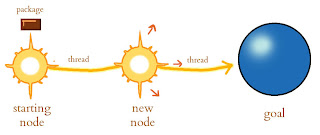
- the player can pull a thread out from the current node and either place a new node in the world or connect to a pre-existing node
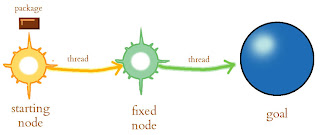
- threads have a fixed length, but the new node can be placed anywhere in the players viewport (as long as not prohibited by another game mechanic)
- when the player travels to a new node, the view will re-orient so that the newly created thread is directly behind the player on a horizontal plane (perhaps this should eventually be that it re-orients to the view that best encompasses the path behind them)
- the current orientation is shown with a skybox that is darker at the bottom than the top
- the player can draw an adjacent thread back into the current node to erase the path
- there is a limit to the number of new nodes that can be produced from a pre-existing node
- the aim is to create a pathway that the package can travel along from the starting node to the planet
- the package will only move when there is an unbroken path that leads all the way from the starting node to the planet
Other mechanics:
- levels with pre-existing networks that have to be erased to limit the package to a single path
- levels with fixed networks where the package has a specific movement pattern that the player can exploit (eg. the package will always go left at a fork in the path)
- different coloured nodes with individual attributes such as specific thread length, different limits on the number of nodes that can be created from it
- multiple packages with different attributes (eg. a red package that cannot travel through across blue nodes)
Obstacles/game elements:
- 'black suns' that suck in nodes and destroy the path
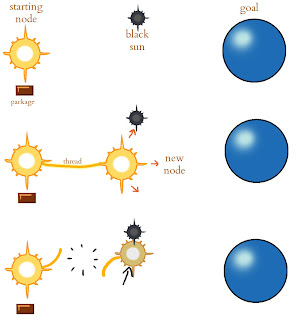
- areas that the player cannot travel through
- areas that the package cannot travel through
- areas that threads cannot be drawn through
- eddies that shift nodes and/or threads
- teleport points
Sound:
- all sound effects in the game would ideally be musical and harmonic, with an underscoring ambient atmos effect, so that the SFX accompanying actions taken in-game create an ambient soundscape
- audio feedback about obstructions could be included as dissonant sounds, to cue the player to look around for the obstacle
Other visual elements:
- the void can be filled with weird and wonderful visuals that add to the ambience, such as clouds of gas or vapour, strange creatures or symbols ghosting out of the background
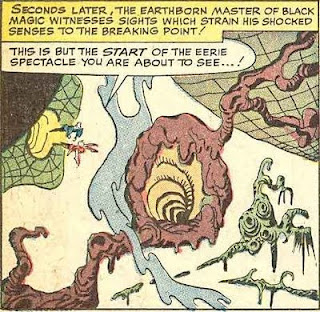
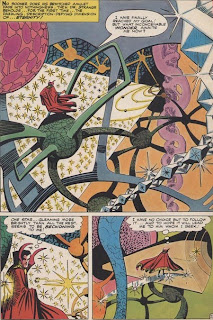

I think these images give a really good feel for the sense of disorientation in a 3D space and the lack of easily identifiable absolute directions.
Potential problems/other issues of interest:
- until the game is prototyped there is no way of knowing how well the player will deal with the sense of disorientation and constant re-location that forms the core of the game (it may turn out to be simply too difficult)
- how to teach the player the mechanics - should they learn by exploring? Should there be a series of tutorials at the beginning of the game to help the player?
- what is the interface for placing nodes?
- is there a classic fixed GUI, or a dynamic one, or simply appropriate in-game indicators?
- will the player need/want an overarching story or can the game simply be surreal verging on abstract?
- the levels need to be designed (to attempt to randomly generate something this complex would be a horrible coding nightmare)
- consequently, how much content can be generated for this game?

No comments:
Post a Comment